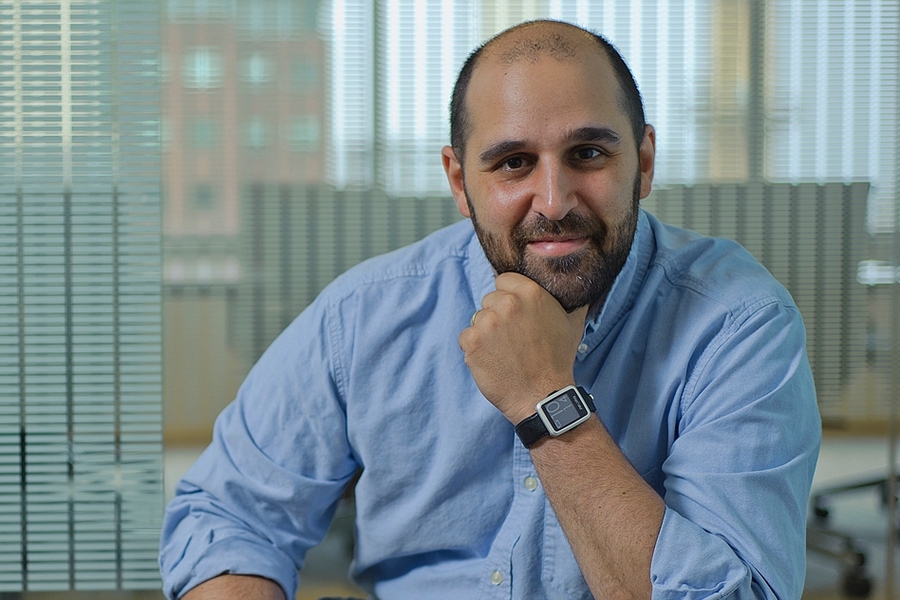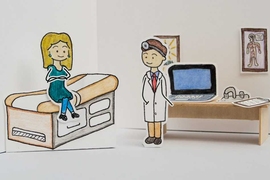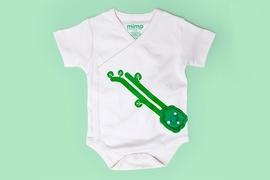Robert Goldberg never spent much time thinking about fashion. All that changed six years ago, however, when as a visiting neuroscientist at John Gabrieli’s lab in MIT’s Department of Brain and Cognitive Science, he co-founded Neumitra. The Boston-based company develops wearable health sensors and analytics software that measure stress, a condition that Goldberg says costs the United States $150 billion in lost productivity and more than $190 billion in health care costs every year.
“I’ve probably looked at over 100,000 wrists over the last few years,” says Goldberg, now Neumitra’s CEO. “I look at wrists everywhere I go.”
That newfound fashion sense has helped define the trajectory of the company. “People don’t all like to wear the same thing,” Goldberg says. To meet Neumitra’s goal of compiling a large data sample for studying stress, and helping as many people as possible gain control over the condition, the technology needed to be integrated into as many wearables as possible. It was unlikely, Goldberg says, that millions of people would choose to wear a new health bracelet from a small startup.
The co-founders collaborated with a wide variety of wearables manufacturers to integrate their analytics software into health-monitoring devices, from smartwatches to fitness bracelets to jewelry. The strategy — and the Neumitra technology — have been a hit with investors. Early investments came from Rock Health, Yahoo, General Magic, Peter Thiel’s Breakout Labs, and, more recently, NetScientific.
Startup by collision
Goldberg met his future co-founders — Anand Yadav and Safiyy Momen — in 2009 at an MIT class, Neurotechnology Ventures. “The class was the kind you could really only find then at MIT,” Goldberg says. “Neumitra was made possible by the collisions between different disciplines that MIT enables.”
Yadav is a biotechnologist, and Momen is an algorithms engineer who had been working on ballistic missiles at MIT’s Lincoln Labs. With Goldberg, the trio decided the time was right to develop low-cost devices to measure and analyze stress. Then and now, the key neuroscience research tool was neuroimaging — but the technology still has its limits. “It’s amazing what neuroimaging can show you, but it only gives you about an hour of information at the cost of thousands of dollars,” Goldberg says.
At the time, health care wearables were limited and very expensive. Yet Goldberg realized that with increasing miniaturization and dropping sensor prices, the consumer wearables market would soon take off. “Some people told us we had to choose between being a medical or consumer device company," he says. "We decided we could be both, and we were proven right. These two worlds are quickly converging.”
The company began developing stress detection algorithms and designed a bracelet prototype called Bandu that primarily depended on skin conductance sensors, also known as galvanic skin response (GSR) or electrodermal activity (EDA). The project led to the realization that “building good hardware is very difficult,” Goldberg says.
The Bandu was scrapped for an improved, Bluetooth-enabled Neuma BioWatch, which added ambient temperature and 3-axis motion detection to EDA readings. By the time the Neuma came out, Neumitra had already shifted to the new strategy of focusing on analytics instead of hardware. The company is now developing a series of biomodules using an array of sensors — including EDR and heart-rate sensors — that can be easily integrated into commercial wearables.
“We’re working with device makers to embed our biomodules in devices they’re already building,” Goldberg says. “What we offer at Neumitra is our algorithms, which depend heavily on data fusion, so our hardware partners get better quality data.”
Getting in touch with stress
Stress, which reflects the sympathetic “fight-or-flight” part of the autonomic nervous system, “is a basic fact of biology that keeps us alive, but it’s been a problem for us throughout history,” Goldberg says. “Stress affects heart function, breathing, digestion, even fertility. From animal models and neural imaging, we know that stress limits the ability to form new memories, to focus, and to make creative decisions. Under chronic stress, we tend to be less happy and more volatile.”
There are times when stress is advantageous — like if you’re being chased by a lion or cranking out a project on deadline — but there’s a cumulative effect that takes a toll, Goldberg says. “Stress is necessary at times, but the problem really comes from acute and chronic stress. If you confront tough deadlines or social encounters every day, it can whittle away at your best capabilities.”
In addition to selling its biomodules and analytics, Neumitra has a consulting business in which it works with large organizations to help them monitor and analyze the stress of their workers. “We can help companies understand how stress affects different parts of the organization or even one type of role,” Goldberg says.
The conclusions from such research, however, can conflict with business as usual, Goldberg says. “One of the biggest challenges we face is the notion that stress is necessary, that you’re not really working hard if you’re not experiencing stress,” he says. “Yet, organizations are coming to understand that stress affects productivity, long-term health care costs, and morale.”
Stress affects most professions and both the rich or poor. Yet, knowledge workers (whose jobs involve handling or using information) are at a particular disadvantage from chronic stress, because they’re expected to use the best capabilities of their brains day in and day out, Goldberg says. Neumitra is working with a software company, for example, to research how stress affects its programmers. “Programming requires a balance between short and long-term memory combined with problem solving skills," Goldberg says. "When programmers are stressed, they are more likely to submit bugs, which are expensive to fix. So this is a cost driver.”
One of Neumitra’s key innovations is its integration of contextual data with other data from multiple sensors. The Neumitra service provides a mobile app that links sensor data with contextual information — such as calendar data and GPS location. The algorithms are also self-learning — if your Neumitra bracelet vibrates to alert you about a high stress level while you’re exercising, for instance, you can click on the equivalent of a "thumbs down" button to instruct Neumitra to ignore a similar signature in the future.
“Stress detection isn’t reducible to one sensor or algorithm, which on their own aren’t sufficient to provide useful feedback,” Goldberg says. “Luckily we all have these computers in our pockets called smartphones. When you combine smartphone data with physiological data, you can learn a tremendous amount about how people, places, and events affect us.”
People are less aware of what stresses them out than they think, Goldberg says. “As a neuroscientist, I thought I understood stress, but I had no clue. I was amazed to find that social situations stress me out. I’m most relaxed when I’m at home quietly working with large data sets.”
While we all have our own particular stress triggers, the data collected from Neumitra users suggests there are certain fairly universal factors, such as participating in a tense meeting or facing a tough deadline. There were some surprises, however, such as the high levels of stress created by eating lunch at your desk while you work.
Just getting to work can boost stress levels that are hard to dissipate in a workday, where meetings and deadlines add to a snowball effect. “The morning commute is one of the most stressful times of the day,” Goldberg says. “People are literally fighting to get into the office on time. When you get there, you’re so overwhelmed by stress, you’re not able to do your best job.”
Neumitra does not presume to tell you whether you should avoid particular stress triggers. “We don’t believe it’s up to us to differentiate between good versus bad stress,” Goldberg says. “Instead, we give the information to the individual and let them decide.”
Goldberg offers the example of people who are stressed out by going on dates: By avoiding such situations, they may lower their stress, but miss out on future happiness. He adds that, as the CEO of a startup, he has no choice but to spend much of his day in potentially stressful social situations.
“Sometimes you can’t do much with the feedback, but you can still come back later and address it,” Goldberg says. The mobile app provides users with visualizations and stress management tools, such as playing music or games, or suggesting activities like taking a walk. “There are many ways to manage stress, so we try to help users find out what works best for them and when. Sometimes you have time to take a nap, or do meditation or yoga, but other times you only have enough time to play a song.”
The Neumitra wearables can be worn day and night, thereby revealing connections between stress and sleep that “were a real surprise to me,” Goldberg says. “We’re beginning to see how stress affects the way you sleep, and how the lack of sleep affects the stress you feel the following day. Stress and sleep are two sides of the same physiological coin: the sympathetic versus the parasympathetic nervous system. They are constantly at tension and not always in ways that we understand.”
Boston stress study to quantify city’s stress
As the number of Neumitra users grows, the company is learning a lot about the differences in stress among organizations, professions, genders, socioeconomic classes, and even countries. “It surprised me that stress rates are not only higher in cities than rural areas, but [also] higher in some countries compared to others,” Goldberg says. “Ultimately, that’s how we’re going to solve stress, by looking at data across all humanity.”
As a next step, Neumitra is launching a Boston Stress Study in late 2015, with first results expected in early 2016. The company has already signed up more than 1,000 Boston residents to wear Neumitra bracelets, with plans to expand that. The participants include a diverse range of roles, from students to police officers to CEOs. Partners include hospitals, companies, and other organizations, such as MIT and Harvard.
“We’re working with a wide range of partners to help make it a much bigger study,” Goldberg says. “Our model is the Framingham Heart Study, which started in 1948 with 5,209 people. It’s now on its third generation, and has taught us pretty much everything we know about the heart.”
The Boston Stress Study will examine how stress affects the city at large, as well as specific organizations, both in real-time and over the long term. “We will develop a map of how and when we experience stress by commute type, profession, location, gender,” Goldberg says. “By working with us on the study you’ll not only learn how stress is affecting your organization, but [also] how stress affects us all. For the first time, we will begin to understand how our daily lives are driving ourselves just a little bit crazy.”









